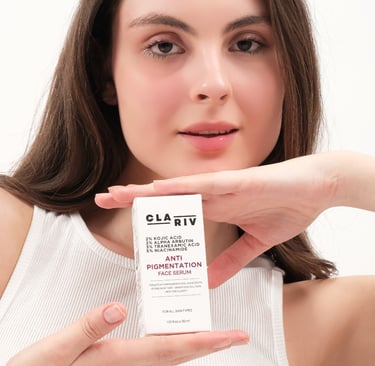FIRST TIME BUYER ? - Use Code FIRSTTIME to enjoy 5% additional discount on entire store
How to Use Anti-Pigmentation Serum Correctly
Learn how to use Anti-Pigmentation Serum correctly for faster results. Step-by-step guide to fade dark spots and even skin tone naturally and effectively.
11/11/20253 min read


Fading Pigmentation Is Not Just About What You Use — It’s About How You Use It
Pigmentation, dark spots, and uneven skin tone are among the most common skin concerns. Most people invest in good serums but still don’t see results — not because the serum doesn’t work, but because it isn’t used correctly.
Using your anti-pigmentation serum the right way can make a huge difference in how quickly you see results. It helps the active ingredients penetrate deeper, fade existing spots faster, and prevent new pigmentation from forming.
Let’s go step-by-step through the right way to use an anti-pigmentation serum effectively and safely for visibly brighter, even-toned skin.
Step 1 – Always Start With a Clean Base
Before applying your serum, make sure your skin is clean and free from dirt, oil, or leftover makeup. If there’s any barrier on your skin, it prevents the serum from absorbing properly.
Use a gentle cleanser and pat your face dry with a soft towel. Avoid rubbing harshly, as friction can worsen pigmentation.
Pro Tip: Apply serum on slightly damp skin — it helps boost absorption and keeps the skin hydrated.
Step 2 – Use the Right Amount and Technique
A common mistake people make is either applying too much or too little serum. For the entire face, 3–4 drops are enough.
Place the drops directly on your cheeks, forehead, and chin. Then, using your fingertips, gently dab and press the serum into your skin. Don’t rub it aggressively — that can cause irritation.
You’ll know you’re doing it right when your skin feels slightly tacky, not sticky.
Step 3 – Let the Serum Absorb Completely
Once applied, give the serum 60–90 seconds to sink in before applying anything else. This waiting period ensures that active ingredients like Kojic Acid, Alpha Arbutin, and Niacinamide can penetrate properly and start working at the deeper layers of your skin.
Rushing this step by immediately layering a moisturizer or sunscreen can dilute the serum’s potency.
Step 4 – Seal It With Moisture
After your serum has absorbed, apply a lightweight moisturizer. This helps seal in hydration and prevents water loss.
A well-moisturized skin barrier allows the active ingredients to perform better and reduces the risk of dryness or irritation.
If you have oily or combination skin, pick a non-comedogenic moisturizer that doesn’t clog pores.
Step 5 – Don’t Skip Sunscreen During the Day
No matter how effective your anti-pigmentation serum is, it won’t show results if you skip sunscreen. UV rays are the top reason pigmentation forms and worsens.
Even when indoors, UV and blue light exposure can darken existing spots. Apply a broad-spectrum sunscreen (SPF 50 or higher) every morning, and reapply every 3–4 hours if you’re outdoors.
Think of it this way — your serum repairs the damage, and your sunscreen protects that progress.
Step 6 – Use It Consistently
The key to fading pigmentation is consistency. Use your anti-pigmentation serum twice a day — once in the morning before sunscreen, and once at night before moisturizer.
Pigmentation doesn’t fade overnight. But with regular use, you’ll notice visible improvement in about 3–4 weeks — fewer dark spots, smoother texture, and a natural glow.
Consistency builds confidence — and clear skin.
Step 7 – Avoid Over-layering and Harsh Combinations
It’s tempting to use several skincare products together, but overloading the skin with too many active ingredients can cause irritation.
Avoid combining your pigmentation serum with exfoliating acids or retinol on the same night. If you want to use both, alternate between nights. This gives your skin time to rest and repair.
Step 8 – Track Progress, Don’t Rush It
Take a photo every 10 days in similar lighting to see how your skin is improving. You’ll notice subtle changes — dark spots getting lighter, and your overall complexion looking brighter.
Be patient. The process is gradual but steady when done right.
Why Following the Right Method Matters
Even the most advanced serum won’t work if it isn’t used correctly. But when applied the right way — clean skin, consistent routine, and daily sun protection — you maximize the results and prevent new pigmentation from forming.
Look for serums that include clinically proven ingredients like:
Kojic Acid – Helps reduce melanin production and fade existing pigmentation.
Alpha Arbutin – Brightens and evens out skin tone gently.
Tranexamic Acid – Helps treat stubborn pigmentation like melasma.
Niacinamide – Strengthens the skin barrier and enhances radiance.
These ingredients are commonly found in dermatologist-formulated serums designed for Indian skin, making them safe for daily use and effective in humid climates.
The Bottom Line
Using an anti-pigmentation serum correctly can transform your skincare results. It’s not about applying more — it’s about applying smarter.
Cleanse, apply, hydrate, protect, and repeat — that’s the golden five-step rule for healthy, glowing, even-toned skin.
When you combine science-backed ingredients with a consistent routine, pigmentation begins to fade naturally and your real skin radiance returns.
If you’re looking for a serum that’s gentle yet effective on Indian skin, explore formulas enriched with Kojic Acid, Alpha Arbutin, Tranexamic Acid, and Niacinamide — the same actives trusted by dermatologists worldwide.
✨ Use it consistently, protect your skin daily, and watch your dark spots fade gradually — revealing a healthier, brighter you.
info@clariv.in
+91-92204-02087
